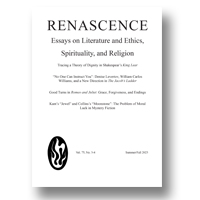|
|
|
1.
|
Renascence:
Volume >
65 >
Issue: 3
Ed Block, Jr.
Senior Editor’s Page
view |
rights & permissions
| cited by
|
|
|
|
|
|
|
2.
|
Renascence:
Volume >
65 >
Issue: 3
Fr. David N. Beauregard
Moral Thrology in Sir Gawain and the Green Knight:
The Pentangle, the Green Knight, and the Perfection of Virtue
abstract |
view |
rights & permissions
| cited by
With reference to the virtue-ethics tradition, especially the system of St. Thomas Aquinas, this essay interprets the pentangle emblazoned on Gawain’s shield as symbolizing the perfection of interconnected virtues, and the Green Knight as figuring Christ in his martyrdom. Linking these two strands of meaning is the Thomist idea of fortitude, the virtue under particular scrutiny in the poem. Gawain fulfills the secondary part of fortitude, attack, while the Green Knight fulfills the primary part, endurance, and is identified with Christ. His axe, holly bob, and green coloration, and even his menacing aspect, all foster this significance.
|
|
|
|
|
|
|
3.
|
Renascence:
Volume >
65 >
Issue: 3
Darlene Kelly
A Bird Between the Prison Bars:
Gabrielle Roy’s Spiritual Calling
abstract |
view |
rights & permissions
| cited by
Through the lens of her meandering faith journey, this essay reviews the work of the celebrated Canadian writer Gabrielle Roy. A metaphor Roy used in an interview, that of life as a prison and the artist as a bird singing between the bars, provides a common theme in the shifting religious attitudes of her writings. At times her attitude grows bitterly satirical, with a “broad steak of anti-clericalism” (The Cashier). But Roy’s spirituality shows through in how she was affected by her two sisters’ illnesses and deaths. If a prison, life was still able to grant “sacramental moments” pointing to a “radiant world beyond this one.”
|
|
|
|
|
|
|
4.
|
Renascence:
Volume >
65 >
Issue: 3
Sr. Ann Astell
“My Life is a Work of Art”:
Oscar Wilde’s Novelistic and Religious Conversion
abstract |
view |
rights & permissions
| cited by
With reference to Wilde’s personal religious struggles, especially the suppression of his long-standing attraction to Roman Catholicism, this essay reads De Profundis, Picture of Dorian Gray, and “Ballad of Reading Gaol” as the author ‘s symbolic working out of his conversion, both spiritually and as a novelist. In the latter sense, the essay draws on the theory of Rene Girard regarding novelistic conversion: the artist’s “disavowal of the mimetic desire that has enslaved him to his models.” Since Christ is in Girardian terms the only model to imitate in safety from envy and violence, Girard’s theory offers insight into Wilde’s views on Christ as individualist and on life as imitation of art.
|
|
|
|
|
|
|
5.
|
Renascence:
Volume >
65 >
Issue: 3
Thomas Wortham
William Dean Howells’s Spiritual Quest(ioning) in a “World Come of Age”
abstract |
view |
rights & permissions
| cited by
A massively prolific man of letters in fin de siècle America, William Dean Howells experienced spiritual conflict and doubt throughout his long life. Opening with the bleakness of A Modern Instance, this essay examines some of the important points in Howells’s religious evolution. Influenced by Tolstoy and certain Protestant progressives, Howells felt that religion “should be motivated by the spirit of love, not adherence to some creed.” This emphasis on “the interrelatedness of our lives” appears in The Minister’s Charge and A Hazard of New Fortunes, but Howells’s spiritual crisis grew acute with the death of his daughter Winifred. The poetry collection Stops of Various Quills reflects this grief, but his spirituality remained complex, as evidenced in “a Circle of Water” and The Leatherwood God.
|
|
|
|
|
|
|
6.
|
Renascence:
Volume >
65 >
Issue: 3
Notes on Contributors
view |
rights & permissions
| cited by
|
|
|
|





